Logistics, logistics, research, research, planning and more planning are all critical and to me are enjoyable parts of each of my 50 species in a day quests for each state. I need to know not only which species are possible and where to find them but also how to best plan a route that allocates the right amount of time in each place that I have to stop to find the different species that I need. In many states that is simply a matter of picking some terrific Ebird Hotspot or two and then covering them sufficiently to get the count. Especially with the shorter days of winter which means less time for birding, travel time and distances between areas are critical considerations. Efficiency is essential. For the most part Hawaii does not have hotspots where with diligence and maybe without even any luck 30 or 40 or maybe even 50 species at a single location are possible. There would be some some spots where 20 or more species might be found, but they would most likely be many of the same species to be found at another good spot.
Accordingly, adding one or two birds here and there in multiple places to get to 50 species for the day would be necessary. And the more stops that were necessary the more critical efficiency becomes. Knowing which spots to visit and then exactly where to go within each spot can save 10 to 30 minutes at each of the multiple places. That adds up especially when the locations are distant. I am not a good birder by ear but with the help of various apps I can at least confirm the ID of a song or call that I might hear. In Hawaii, I would know none of the calls and had no app to use to help. Finally there are just not that many species in Hawaii, period. For all of these reasons, I decided that this was a state where professional assistance was necessary. Furthermore this would be the best way to get a really local perspective and an education on the culture and natural history of the area. I was able to arrange a full day of birding with Lance Tanino and it worked out very well.
My Guide – Lance Tanino

In many ways this was a new kind of experience for me. Not only was I unfamiliar with the area and the birds, I was also going to be relying entirely on the logistics of my guide to choose places, timing and route. Lance had himself done a couple of Big Days which gave me a lot of confidence but they had been later in the year when the birds were somewhat different and the days longer. In a preliminary phone conversation he suggested a long route that would have us birding in many areas all over the Island … if there was time. I did not recognize it then, but a key spot was to be the Aimakapa Ponds that I had visited in the afternoon the day before the Big Day after flying in from Maui. As described in my previous blog post, I had excellent birding there with 23 species including some rarities. [The Day Before and the Day After the “Big Day” in Hawaii – https://wordpress.com/post/blairbirding.com/21687%5D
As with other states in my 50/50/50 adventure, getting to 50 was the most important factor but hopefully that would include some species of special appeal which in Hawaii definitely meant some of the endemic native species. They are only found in native forests – primarily at small preserves at altitude on Mauna Kea or at Hawaii Volcanoes National Park. The number of species is relatively low and the time spent finding them – including possibly long hikes can be significant. Balancing interests, I made the executive decision that getting some of those species was very important and that if necessary I could stretch the rules a little bit and include that hour of birding at Aimakapa the previous day on the species list for the Big Day – and then I would not count any birds seen during that same hour on the Big Day. That hour could be used for travel or lunch but no birds … again if necessary, which I hoped it would not be. This gave some security in case it took a long while to see the native birds and we would not have to get to Aimakapa Ponds on the Big Day which was to have been an important but time consuming stop. Lance modified the plan accordingly and we would start the Big Day at 7:00 a.m. the next morning beginning at the same Ulu La’au Waimea Natural Area that I had birded late the previous day.
Our Big Day Route
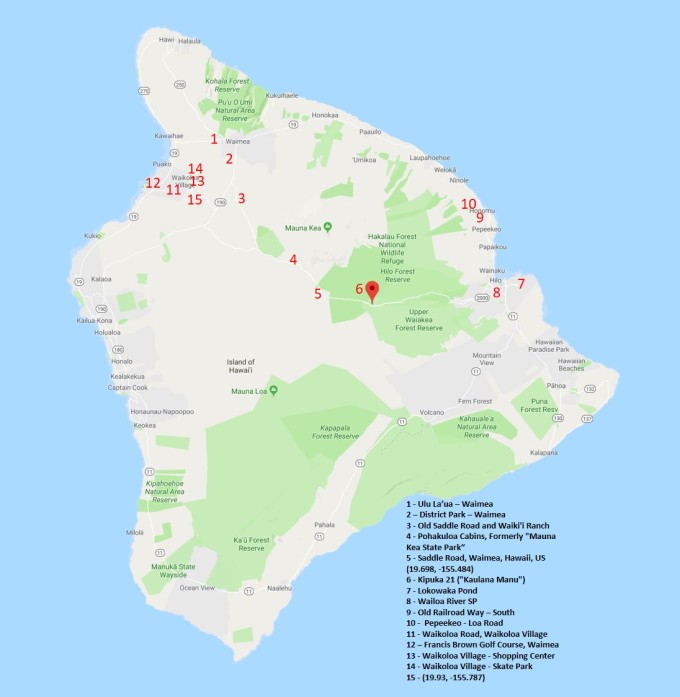
At Ulu La’au, It was immediately obvious that having a great guide would make a huge difference as Lance had great ears and quickly identified many calls and songs that I had missed the day before or heard but could not identify in any event. We had all of the species I had seen the previous day except for Common Waxbills and African Silverbills, but also added four gallinaceous birds – Black, Gray and Erckel’s Francolins and Kalij Pheasant – plus Northern Mockingbird, Saffron Finch, House Finch and Japanese Bush Warbler. The Black and Gray Francolins and the Bush Warbler were heard only. Lance had asked if “heard only’ species would count. My response was “yes” but only if I heard them and if with his instruction I could then on my own identify the calls. Fortunately the calls were distinctive and repeated enough to qualify. The one bird we missed that Lance expected “for sure” was the Red Billed Leiothorix. As reported in my previous blog post, I was able to find them in this location the next morning.
Waimea Natural Area – Ulu La’au

Erckel’s Francolin

Kalij Pheasant – Male and Female


The most numerous birds were both Spotted and Zebra Doves and Northern Cardinals which were calling almost constantly while we were there. The Cardinals and Mockingbird seemed so out of place.
Zebra Dove

Northern Cardinal Female

Northern Mockingbird

Saffron Finch

We left around 8:30 a.m. with a list of 20 species – an excellent start. Next we headed Southeast to open country along Saddle Road (Highway 200 after leaving Highway 190). We found more Gray Francolins along the way to an open area that was good for Eurasian Skylarks and hopefully a Short Eared Owl. At first Skylarks were heard with their distinctive calls high above us. Then we had several fly closer and land on the ground not too far away, grazing and then taking off again. Counting the ones seen here and then at several other spots later, there may have been two dozen – more than I have seen during my entire life. We also at first heard the “clucking” calls of a Ring Necked Pheasant and then had a distant visual. Later one came very close behind a fence separating us from one of the fields with some of the Skylarks.
Gray Francolin

Eurasian Skylark

Ring Necked Pheasant

It took longer than expected but we finally saw first one and then a second Short Eared Owl hunting low over the field maybe 250 yards out. We also had two Hawaiian Geese fly by in the distance. Each species mattered for the count of course. We continued our drive climbing onto the lower slopes of Mauna Kea and had a very close flyby of another Short Eared Owl. Unfortunately there was no opportunity to pull off the road for a photo. We watched the fields hoping for some Chukars and were shortly rewarded with a feeding group of more than a dozen.
Chukar

All of the game birds on the Hawaiian Islands have been introduced for hunting. Some are restocked on a continuing basis but the populations are self sustaining. The only game bird we missed were California Quail. We searched for them along the road and also at the Pohakuloa Cabins (formerly Mauna Kea State Park). At the cabins, we found the first of our native Hawaiian species, though, a calling and then flying Hawaiian Amakihi. Missing the Quail and the Leiothorix earlier put us two down for the day.
Hawaiian Amakihi (This photo is by Grace Oliver another Seattle area birder from her trip in 2014)

There was one confusing stop/nonstop. We had started up the Palila Discovery Trail – the best place to find the endemic Palila with a chance for other native species. Four wheel drive is required as is a permit. My jeep was 4 wheel drive but this was misunderstood and it was not clear if Lance had the necessary permit. When we saw a government vehicle not far up the road, we turned back. Another miss…
Palila (Internet Photo)
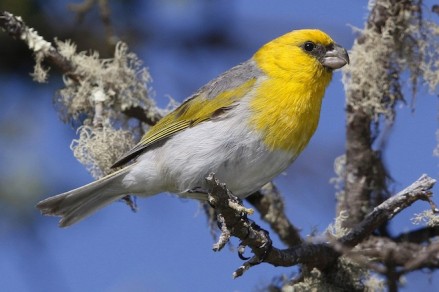
We continued along the highway until we reached our only true native forest area at an elevation of over 6,000 feet, the Kaulana Manu Nature Trail . It is what is known as a “kipuka” – in this case Kipuka 21. A kipuka is a forest pocket spared from lava flows. There are only remnants of what used to be an extensive native forest full of native birds. Today they are found only on the slopes of the high volcanoes. Thousands of acres have been destroyed by lava flows and from grazing by feral goats and cattle and clearing by ranchers. As we hiked into the thick forest, Lance identified one native plant after another – dozens of them. Many were flowering or with seeds – the reason that the birds survive.
Most prolific of the native honeycreepers, were the Apapane – brilliant red with black wings and bright white under tail. Usually buried in the thick foliage, one posed in the open for several moments. Harder to find, harder to see and much harder to photograph was the I’iwi with its extremely decurved bill.
Apapane


I’iwi


Another native bird we found was the Oma’o or Hawai’i Thrush. Unfortunately the trail was so narrow that I could not get past Lance for a photo without flushing it. I settled for great looks of one and heard calls from many others.
Oma’o or Hawai’i Thrush – Another Photo by Grace Oliver

Lance’s keen ears picked out the chattering call of the Hawai’i Elepaio. I had a two second look of the bird buried in foliage above me and then it flew across the narrow trail into even thicker brush past Lance. The only ID marks I could make out were a brownish color and a cocked tail – wren-like. The photo is from a blog by Pedro Lourenço.
Hawai’i Elepaio

Lance motioned to come quick. Soaring above us was a Hawaiian Hawk. Another endemic, it was a species that I had not expected to see. It circled in brilliant light for several moments and then disappeared. Lance said that most people found it reminiscent of a Broad Winged Hawk, a similarly sized buteo. Although it quickly disappeared we were very happy with the observation. Several minutes later as we continued through the forest, we heard a crashing noise in the trees and then the Hawk flew right past us and perched in a snag overhead. This was probably the highlight of the day for me.
Hawaiian Hawk


We commemorated the moment with a photo of me (with new beard) in the native forest – definitely the oldest bird of the day!!! When we left the forest, our species count was at 33 species. There was work to do and we headed east towards Hilo for waterfowl and other lowland species.

At Lokowaka Pond, we had the best bird of the day for Lance as we located a Cinnamon Teal that had previously been seen at the next pond we would visit but had been missed on several tries by Lance. We also added Mallard, Black Crowned Night Heron, Hawaiian Coot and Lesser Scaup. As is still the case for Mexican Ducks, the “Hawaiian Ducks” we found are considered subspecies of Mallard and are not countable. There were also more than 100 Cattle Egrets.
Cinnamon Teal
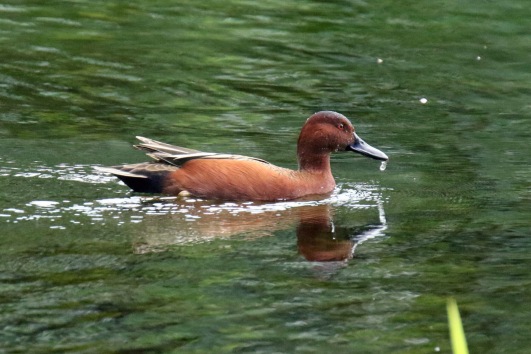
Black Crowned Night Heron

“Hawaiian Duck” – Koloa

Cattle Egrets

Our next stop was Wailoa River SP — Waiakea Pond, a much larger area with lots of waterfowl including Canada Geese, Hawaiian Geese, a very hard to find Greater White Fronted Goose, Muscovy Duck, Mallards and 3 Ring Necked Ducks. Lance also located a single Wandering Tattler. We searched unsuccessfully for the Pied Billed Grebe that had been seen there regularly and we also failed to find a couple of other duck species that were possibilities. However, the new waterfowl at both ponds brought our species count to 43. I knew that there were 6 species “in reserve” from the previous day’s visit to the Aimakapa ponds. So one way or the other, I was now relaxed that the magic 50 would be reached – but hopefully with new species ahead for this day.
Muscovy Duck

Ring Necked Duck

Greater White Fronted Goose

We headed off to areas along the coast north of Hilo looking for small finch like or grass birds to add to our count for the day. Chief among our targets were Chestnut Munias and Red Avadavats. We failed to find the Chestnut Munias but were successful in finding a few Red Avadavats which due to its mix of colors and marking became one of my favorite birds for the day and the trip as a whole. We also had many Saffron Finches, Common Waxbills, Yellow Fronted Canaries, House Finches and Scaly Breasted Munias. Many of these birds eat the seeds of Guinea Grass (among others) and we found these grasses in many areas, but often the grasses had no seeds having been already stripped bare and it was fascinating to see how in these cases there were no birds while in areas where the seeds remained, there were often many.
Yellow Fronted Canary

Scaly Breasted Munia on Guinea Grass (with seeds)
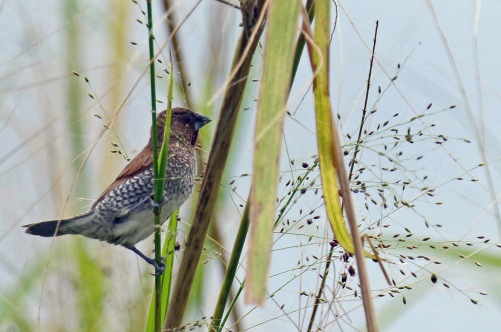
Common Waxbills

Red Avadavats



We also did some ocean scans looking for any marine birds, but just as my experience had been throughout my week long visit, no birds were seen. The Avadavats were the only new species added and it was beginning to look like I would have to add the Aimakapa birds to get to 50. But Lance had other ideas and we headed back west towards Waikoloa.
Along the Waikoloa Road just before getting to Waikoloa Village we saw first some Gray Francolins and then later two Chestnut Bellied Sandgrouse. The latter was one of the species that I most hoped to find and photograph. Unfortunately they were on the passenger’s side of the road and as I pulled over and tried to position myself for a photo, a truck came by and off they flew. Lance thought there would be a good chance for more and we did revisit the road later, but we never found another one. I include a photo that I sure wish was mine. It is by Michael Weaver from a tour in the same area last October.
Chestnut Bellied Sandgrouse

Another species that was very high on my list was the Bristle Thighed Curlew. They can be found, with luck, in breeding season in Nome, Alaska and in winter they are on some islands in the South Pacific – 4,000 miles away – a long over water migratory flight. The bottom line is that we did not find any at the Francis Brown golf course where they normally hang out. Fortunately I did return and find one there and get a photo the next day, but they would not be on the Big Day list. A consolation prize however was a visual of a Mourning Dove. We had heard one earlier but this observation made it a definite add to the day list. We also had a small flock of Ruddy Turnstones on the course. I had missed the one that Lance had seen earlier so this was a major add. I want to add that Pacific Golden Plovers were found at many of our birding stops. On this one hole at the golf course we had more than a dozen.
Ruddy Turnstone

Pacific Golden Plovers
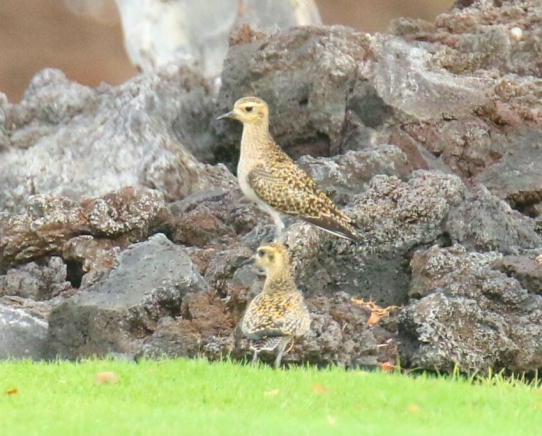
The Sandgrouse, Mourning Dove and Ruddy Turnstone brought us to 48 species. How wonderful it would have been to have had one of our misses and then have the Bristle Thighed Curlew for #50, but we were now oh so close and Lance had a guaranteed new species up his sleeve – Rosy Faced Lovebirds at the Waikoloa Village Shopping Center. Sure enough, a flock of more than a dozen were waiting for us there. We now needed just one more.
Rosy Faced Lovebirds

Recall that at the beginning of the day, we had missed African Silverbills at the Ulu La’au Nature park in Waimea. They had been expected. Lance knew another spot that was good for them an also could have Chestnut Bellied Sandgrouse – the Skate Park at Waikoloa Village. Hopes lessened when we got there and saw that there were people at the Skate Park and at both upper and lower fields. So no Francolins and no Sandgrouse, but there was a small wet spot next to some brushy trees and we could see lots of activity as birds came down to the wet area to drink. On branches just above the wet area, there were two groups of little brown grey birds – African Silverbills. Drum roll please – we had seen 50 species in one very fine Big Day.
African Silverbills

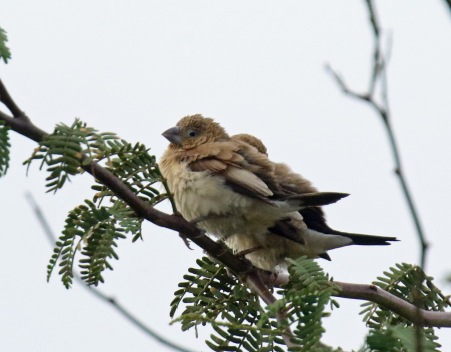
In my other 50/50/50 quests there have been two other times when I wondered if I would reach the goal. In each case I did and then shortly after found additional species to bolster the list. This would be the case again this day. We returned to Waikoloa Road for one last chance to find a Chestnut Bellied Sandgrouse. No such luck but our consolation prize was a flock of 13 Wild Turkeys. They had been another miss earlier and now provided one last species for the day.
Wild Turkeys

When I first considered a Big Day in Hawaii, I thought it possible but by no means guaranteed. I was aware of two Hawaii Big Days with more than 50 species but each had included a number of marine species and all had included good birds at the Aimakapa Ponds and a Wastewater Treatment plant. They had also been done by local birders (including by Lance Tanino). With the benefit of hindsight I think with LOTS of research and LOTS of luck I may have found 50 species without hiring a local guide – but it would have been unlikely. I recently learned that the son of a birder I know here in Washington is a serious birder on the Big Island. Maybe I could have made it with his help. But I am extremely pleased with the decision to bird with Lance. Not only was he an expert at identifying all of the birds including by sound only, he was also great company and a deep resource for all of the history – natural and cultural for the Island – an important part of my 50 state adventure.
There had been a couple of surprise or improbable birds during our trip, but there had also been a number of misses and as I said – no marine birds whatsoever. We had also not visited the Aimakapa Ponds or the Wastewater Treatment Plant. With some luck and the longer days later in the year, I think it would be possible to have a 60+ or maybe even a 70 species Big Day but 70 would be incredible. I was thrilled with my 50 species. At the Aimakapa Ponds the day before I had 5 species not found on this day and the following morning when I revisited first Ulu La’au and then the Francis Brown South Golf Course, I had both the Red Billed Leiothorix and then the Bristle Thighed Curlew. They were great adds to my great Big Day. The weather had been perfect on my Big Day – and there was no certainty that it would be, as rain is frequent. In fact just upslope from the city of Hilo, annual rainfall can be an incredible 300 inches!! I returned to 5 days of snow in Washington and then Hawaii also had some brutal weather with high winds and even some snow at the higher elevations. I had been lucky.
I hope to return to this beautiful place someday and spend more time in the remnant forests looking for and hopefully getting my own photos of more of the endemic birds. For now Hawaii is state number 25 finished for my 50/50/50 project. I am halfway there and have a very busy spring, summer and fall ahead of me. I just may make it to the finish line.


Really a cool report Blair, thanks for the photos and details.
LikeLike
Reblogged this on Wolf's Birding and Bonsai Blog.
LikeLike